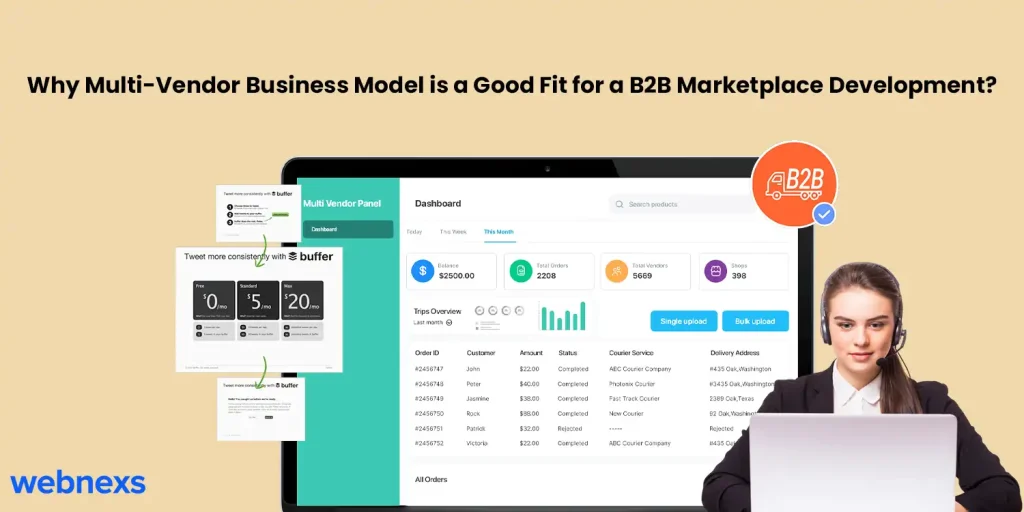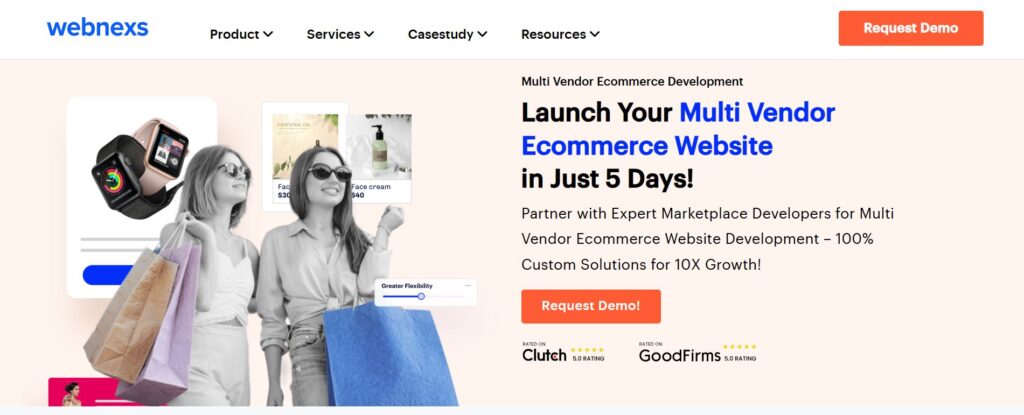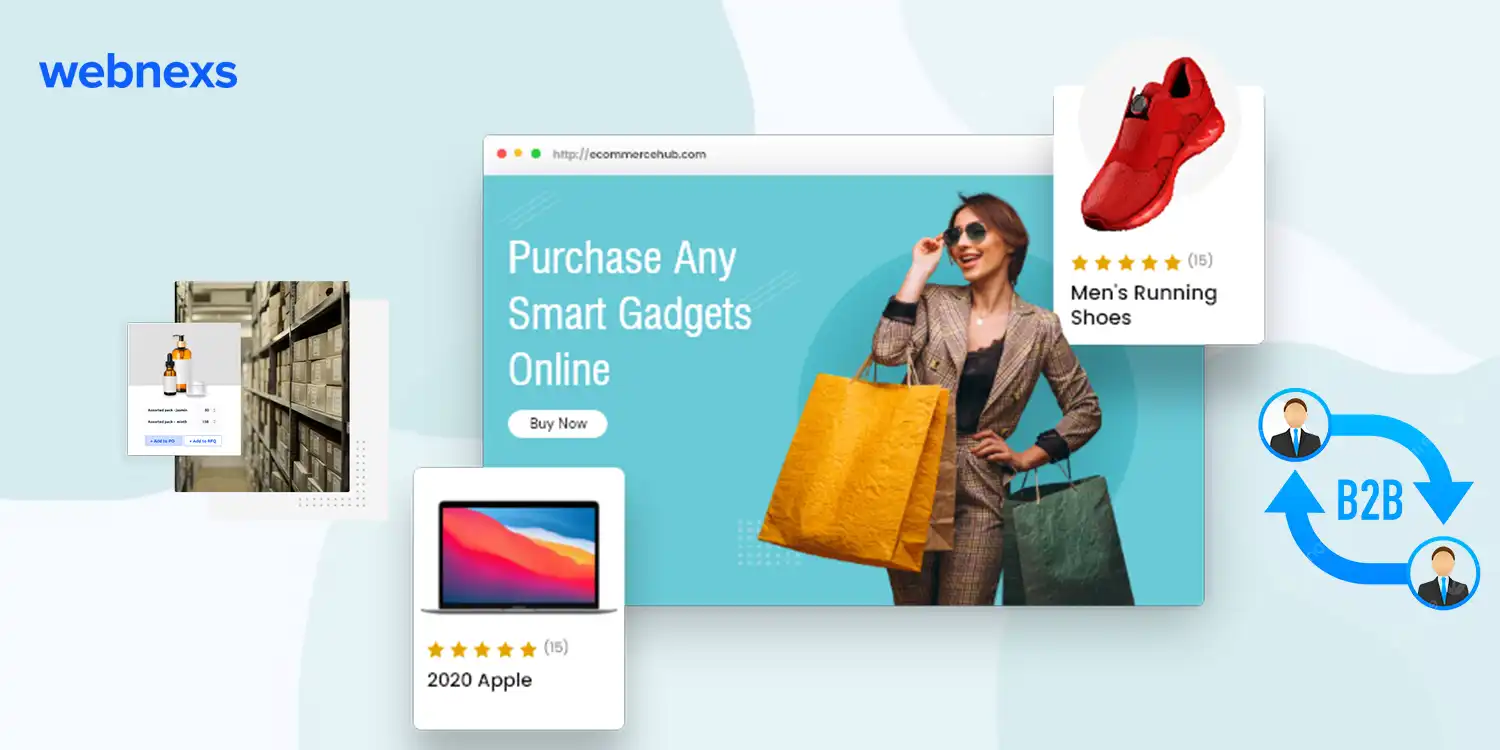Before exploring the answer to “Why start a B2B multi vendor marketplace?” We will explore Why start an ecommerce marketplace?
Digital-First Mindset has become the new norm; 74% of B2B buyers research at least half of their purchases online, according to Forrester. Most of the target audience with purchasing power have their first look online, collecting information.
To add to this, from 2019 to 2024, the percentage of consumers shopping only in physical stores has dropped to below 18%, and it’s expected to fall to around 15% or lower by the end of 2025.
This tailwind of global eCommerce sales is estimated to reach between $8.5 trillion and $9.5 trillion by 2030.
Given the above statistics, it is needless to say that there is immense potential in the ecommerce space for revenue generation.
Now, why B2B multi vendor marketplace?
The top 3 most used services by businesses from other ecommerce businesses represent a greater potential for new entrants to grab a piece of the pie.
- Wholesale Buying:
It is projected to reach approximately $68.52 trillion.
- Raw Material & Inventory Procurement:
It is projected to grow to $1,131.52 billion by 2032.
- Technology Stack & SaaS Services:
It is projected to reach approximately $8.66 trillion.
Additionally, with minimal barriers to entry, global reach, and scalable revenue opportunities, the B2B multi vendor marketplace will reach $25.65 trillion by 2028.
In this blog, we will explore in detail why starting one is an ideal option.
Key Takeaways on B2B Multi Vendor Marketplace
- The positive financial impact, along with the profit-generating potential in this industry, is immense. Tapping into this opportunity will result in a marketplace that scales fast, earns consistently, and delivers long-term value.
- A B2B marketplace platform is specialized with features that exclusively cater to buyers running businesses. The features include bulk ordering, custom pricing, and secure payments.
- The multi vendor B2B marketplace business model is highly profitable, where income can be generated from commissions, vendor subscriptions, ads, data monetization, and premium services, with potential yearly profits exceeding $1.2 million.
- Essential features to operate the marketplace include multi-vendor support, advanced product management, bulk order tools, and secure payment systems.
- Challenges exist, but each has its solution to mitigate and eliminate the barrier and facilitate a smooth operation.
What is a B2B Multi Vendor Marketplace?
It is a platform that allows multiple vendors to list their products for buyers (other businesses) to purchase. A significant distinction here is that the platform provides features that cater to the specific needs of the businesses, unlike a B2C platform.
Features Essential for a B2B Marketplace Platform
1. Multi-Vendor Support
Vendors can operate independently on the platform with vendor-specific features that allow greater flexibility for operation. Besides, they can create their stores, manage product listings, and track orders efficiently. Vendor-specific features allow greater flexibility for operation
Platforms with multi-vendor support see an average increase of 20-30% in sales due to the variety of products and competition among vendors.
2. Advanced Product Management
Large inventories need to be managed with bulk uploads, product attribute customization, and real-time stock updates. Up-to-date storefronts can be managed through efficient product management.
Businesses using advanced product management systems see inventory accuracy rates improve to 95% or higher, reducing stockouts and overstocking.
3. Payment & Invoicing Solutions
The bulk transactions require utmost security and support for invoices, credit terms, and integration with various payment gateways. To further secure, escrow services are offered to protect against fraudulent practices.
B2B multi vendor marketplace platforms with robust payment security features experience a 60% reduction in fraud-related losses.
4. Bulk Order Management
A significantly distinct feature that allows for easy bulk ordering, custom quotes, and volume discounts to deliver an efficient procurement process. As part of this, the Order Management System (OMS) manages the purchase-to-delivery cycle.
Bulk order management systems can increase order processing efficiency by up to 80%, significantly reducing the time from order to delivery.
Read More: Best 60+ Unique Ecommerce Website Features Lists (Updated)
Challenges in Starting a Multi Vendor B2B Marketplace
1. Vendor Onboarding Complexity
The diverse catalogs, pricing rules, and compliance requirements make the onboarding process time-consuming.
Solution: Self-service vendor portal with bulk upload tools, API integration, and onboarding assistance will ensure the process is completed in a time-efficient manner.
71% of businesses reported a reduction in onboarding time after implementing self-service portals in the B2B multi vendor marketplace.
2. Complicated Pricing Models
The varying buyer needs and order volumes make tiered pricing, bulk discounts, and MOQ requirements more complex.
Solution: Implement custom pricing engines for automating support for quote requests (RFQ), volume-based pricing, and negotiation.
There is a 15% to 20% increase in sales revenue after implementing dynamic pricing engines in the B2B multi vendor marketplace.
3. Secure Payments & Credit Terms
The secured transaction process is a concern due to high-value transactions and data sensitivity involved in the purchase.
Solution: Integrate escrow services, invoice billing, net terms, and multiple secure B2B payment gateways.
80% of businesses reported a reduction in payment-related fraud with escrow services and secure payment gateways in the B2B marketplace platform.
4. Establishing Buyer Trust & Product Quality
Sellers’ credibility and product authenticity are concerns for buyers, and they need reassurance, as long-term business relationships are established based on this.
Solution: Implement vendor verification, ratings, and quality control features like sample ordering and compliance badges.
80% of buyers reported increased trust in sellers with verified profiles and badges in the multi vendor B2B marketplace.
Examples of Successful B2B Multi Vendor Marketplace
1. Alibaba
Location: China
Target Audience: Small to medium-sized businesses (SMBs), wholesalers, manufacturers, and suppliers seeking to source or sell products internationally.
Success Driving Factors:
- The driving force behind its success is the coverage of millions of buyers and suppliers with a vast range of products across various industries.
- Sellers can set their prices and negotiate, allowing greater flexibility in operating their business.
- By leveraging technological innovation, the platform was enabled to work faster and smarter, giving shoppers a smooth experience.
Success Metrics:
- Over 48 million small and medium-sized enterprises (SMEs) globally.
- More than 200,000 suppliers in the B2B multi vendor marketplace, with approximately 90% based in China.
- Alibaba reached $4.51 billion in the 2nd quarter of 2024, which is a 29% year-over-year revenue increase.
2. Amazon
Location: USA
Target Audience: Small startups to large enterprises requiring supplies, equipment, and services.
Success Driving Factors:
- Integration into Amazon’s ecosystem of brand and infrastructure has earned trust and credibility.
- Unique needs of the buyers were addressed, along with providing millions of products and tailored pricing models.
- Logistics is fast and reliable.
Success Metrics:
- Amazon’s multi vendor B2B marketplace is projected to account for 2.4% of the U.S. B2B e-commerce sales by 2025.
- Over 6 million customers worldwide, including small businesses, large enterprises, and public institutions.
- 96 of the Fortune 100 companies utilize Amazon Business for their procurement needs.
Why Start a B2B Multi Vendor Marketplace?

The primary goal of any business is to generate profits. While this is a common understanding, we will explore how B2B multi vendor marketplaces can be an effective way to achieve profitability.
Commissions
Each vendor is charged a fee for each sale. Each order is bulk with high value, so the fees add up fast. This means that the rate of earnings is high with consistency.
Vendor Subscriptions
Tiered plans are offered for steady income based on subscription. A predictable and recurring income is earned.
Data and Insights
Monetize by data sharing. Data on buyer behaviour, purchasing patterns, and inventory demand is monetized. This aggregate data can be sold to vendors or other parties.
Advertise on Your Platform
Providing advertising space within the marketplace benefits the advertiser with more visibility and you with a promotion fee.
Custom Services and Integrations
Logistics and inventory management tools are services for which a fee can be charged to vendors or taken from the service providers via the platform.
This loop continues, and additionally, the below-mentioned advantages are gained from the B2B multi vendor marketplace as a result:
Escalating Vendor Base
Once the marketplace is established, your existing vendor base will become a source of word-of-mouth marketing to increase the vendor base.
Volume and Repeat Transactions
More vendor base converts to more purchases, and eventually more repeat purchases and word-of-mouth marketing.
You can generate profits by operating virtually, with minimal effort.
Read More: How to Build the Best Online B2B Marketplace Platform?
We will break down the calculation of profit generation for a new B2B ecommerce store in 2025
ESTIMATED MINIMUM REALISTIC PROFIT (YEAR 1)
| Revenue Channel | Assumptions | Annual Revenue |
| Commissions | 50 vendors × 10 orders/mo × avg $3,000/order × 6% fee | $1.08M |
| Vendor Subscriptions | 30 basic ($49), 15 pro ($149), 5 premium ($399) | $55,920 |
| Data Monetization | Basic reports to vendors or 3rd parties | $12,000 |
| Ads on Platform | Sponsored products, categories | $30,000 |
| Custom Services/Integrations | Logistics APIs, inventory tools, invoicing systems | $60,000 |
While profits can be generated on one side, significant cost savings can be realized on the other. A comprehensive analysis of the actual costs associated with operating a brick-and-mortar store will provide a clear understanding of the potential savings that can be achieved through a B2B marketplace platform.
- Real Estate and Rent: $10,000 to $500,000 annually
- Utilities: $6,000 to $24,000 annually
- Labor Costs: $50,000 to $200,000+ annually
- Store Maintenance: $1,000 to $10,000 annually
- Inventory Management: $10,000 to $100,000+ annually
- Security and Surveillance: $1,000 to $10,000+ annually
- Advertising and Signage: $5,000 to $15,000 annually
- Point-of-Sale (POS) System and Equipment: $3,000 to $10,000+ upfront
SAVINGS: $86,000
PROFITS: $1,237,920
Total Positive Financial Impact (Saved + Earned): $1,323,920/year
This calculation is based on the minimum expenses and profits incurred/generated within a multi vendor B2B marketplace. Unlike a brick-and-mortar store, not only can you generate revenue, but you can also retain financial resources. The key advantage is the ability to reinvest these retained resources into the marketplace, for scaling up the business.
*This is a very realistic and data-backed estimate for 2025 based on trends, assuming the marketplace is moderately successful and focused on a high-value vertical.*
How to Build a Scalable B2B Multi Vendor Marketplace Solution?
Now that you have a clear picture of the industry potential, we will look into how you can build a scalable B2B multi vendor marketplace solution.
1. Register and Legalize Your Business
- Choose a business structure: LLC or Private Limited Company (Ltd).
- Apply for applicable licenses, namely, GST/VAT/Tax ID (based on country), Import/export license if crossing borders.
- Create legal agreements with vendors, and for user protection with GDPR or CCPA.
2. Set Up finances and Payment Handling
- Open a dedicated business bank account
- Choose a payment processor that supports your B2B multi vendor marketplace.
- Register for international payout support if working globally
- Ensure support for split payments
3. Types of Ecommerce Platform Solutions
- White-label solution: Pre-built platforms that can be completely customized to reflect your brand elements.
Unique Advantage: Faster time to market
- SaaS: Subscription-based off-the-shelf platform solution that can be accessed online.
Unique Advantage: Scalability
- Custom Development: Developing and deploying the software from scratch
Unique Advantage: Complete control over functionalities.
4. Onboard vendors
- Identify potential vendors by attending trade fairs, using LinkedIn, and joining industry groups and forums.
- Incentivize early adoption of the platform.
- Initiate product listing
- Provide ongoing vendor support to help navigate the multi vendor B2B marketplace and enable them to optimize sales.
5. Launch
- Set up your domain and configure the DNS to point it to your hosting provider.
- Install an SSL certificate to secure data and ensure trust.
- Test the platform thoroughly, and then go live by making it accessible to users.
Webnexs as Your B2B Marketplace Platform Provider

In a practical sense, a White-label solution and a SaaS solution will facilitate easy operation of the ecommerce platform. A custom-built software will take several months to be deployed; additionally, hosting and managing the platform must be carried out by the client.
Unlike that, white-label and SaaS solutions are devoid of that responsibility, the platform provider undertakes to maintain the platform. You can focus on growing the B2B marketplace platform and rely on the platform provider to manage the technical responsibilities.
Get a free consultation and launch your marketplace sooner with Webnexs.
Wrapping up
It is not solely about the profits earned, but also the positive financial impact the business gains by not spending on operating costs as much as a brick-and-mortar store. In this case, a B2B multi vendor marketplace would be an ideal choice.
This also means more resources for marketplace expansion, which results in a higher rate of plowing back profits. By capitalizing on this opportunity with a scalable, feature-rich platform, your marketplace can perform exceptionally well.




